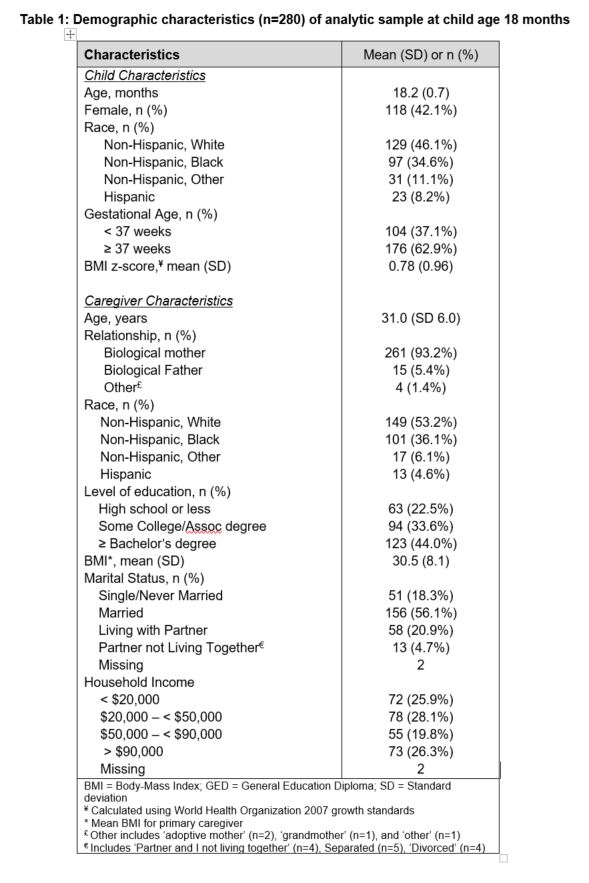Public Health & Prevention
Category: Abstract Submission
Public Health & Prevention III
501 - The Longitudinal Relationship between Parenting Stress and Childhood Sedentary Behaviors in Toddlerhood
Sunday, April 24, 2022
3:30 PM - 6:00 PM US MT
Poster Number: 501
Publication Number: 501.344
Publication Number: 501.344
Amrik S. Khalsa, Nationwide Children's Hospital, Columbus, OH, United States; Rebecca Andridge, The Ohio State University College of Public Health, Columbus, OH, United States; Sarah Keim, Nationwide Children’s Hospital / Ohio State University, Columbus, OH, United States; Bharathi J. Zvara, University of North Carolina at Chapel Hill, Chapel Hill, NC, United States; Sarah E. Anderson, Ohio State University College of Public Health, columbus, OH, United States

Amrik S. Khalsa, MD, MSc (he/him/his)
Assistant Professor
Nationwide Children's Hospital
Columbus, Ohio, United States
Presenting Author(s)
Background: Parenting stress is associated with sedentary behaviors (e.g., increased screen time) in school-aged children. However, the longitudinal relationships between parenting stress and sedentary behaviors in toddlers have not been examined.
Objective: To determine the longitudinal relationship between parenting stress in parents of 18 month old children and children’s sedentary behaviors at 36 months.
Design/Methods: We analyzed data from Play & Grow, a prospective cohort study focused on parent-child interactions and obesity risk during the toddler to preschool-age developmental period. Families (n=300) with an 18-month-old child were recruited from a large academic pediatric medical center between December 2017 and June 2019. Data used in this analysis were obtained from the primary caregiver via questionnaires. Parenting stress was measured (at child age 18 months) using the Parental Distress subscale (12-items, range 12-60) of the Parenting Stress Index-4 Short Form questionnaire. Sedentary behaviors (at child age 36 months) included availability of television (TV) and electronic devices, hours viewed and parental rules around screen time, outdoor physical activity, and sleep routines. Multivariable regression models were used to determine the longitudinal relationships adjusting for child sex, child race/ethnicity and household income.
Results: Data from 280 children were analyzed, including 118 (42.1%) females. Primary caregivers were predominately the biological mother (n=261, 93.2%). The sample was diverse with respect to parental race/ethnicity and yearly household income (Table 1). Mean Parental Distress score was 24.2 (SD 6.6). When the child was 36 months, nearly a third (n=89, 32.8%) had a TV in their bedroom and 111 (41.0%) had a TV on when no one was watching (Table 2). In the adjusted models, for every 1 standard deviation increase in parenting stress at 18m, when the child was 36 months there were increased odds of having a TV in the bedroom (OR 1.36, p=0.052) and of the TV being on in the background (OR 1.26, p=0.04), and decreased odds of the parent having rules on the amount of TV time (OR 0.75, p=0.02) and of the child having a regular wake time (OR 0.77, p = 0.047; Table 3). There were no associations between parenting stress and hours of screen time, outdoor physical activity, or other sleep routines.Conclusion(s): Increased parenting stress at child age 18 months was associated with few child sedentary behaviors at 36 months with small effect sizes. Future work should examine whether parenting stress is more strongly associated with a combination of child sedentary behaviors.
Table 1: Demographic characteristics (n=280) of analytic sample at child age 18 months
Table 2: Frequency table of child sedentary behaviors reported at child age 36 months.jpg)
Objective: To determine the longitudinal relationship between parenting stress in parents of 18 month old children and children’s sedentary behaviors at 36 months.
Design/Methods: We analyzed data from Play & Grow, a prospective cohort study focused on parent-child interactions and obesity risk during the toddler to preschool-age developmental period. Families (n=300) with an 18-month-old child were recruited from a large academic pediatric medical center between December 2017 and June 2019. Data used in this analysis were obtained from the primary caregiver via questionnaires. Parenting stress was measured (at child age 18 months) using the Parental Distress subscale (12-items, range 12-60) of the Parenting Stress Index-4 Short Form questionnaire. Sedentary behaviors (at child age 36 months) included availability of television (TV) and electronic devices, hours viewed and parental rules around screen time, outdoor physical activity, and sleep routines. Multivariable regression models were used to determine the longitudinal relationships adjusting for child sex, child race/ethnicity and household income.
Results: Data from 280 children were analyzed, including 118 (42.1%) females. Primary caregivers were predominately the biological mother (n=261, 93.2%). The sample was diverse with respect to parental race/ethnicity and yearly household income (Table 1). Mean Parental Distress score was 24.2 (SD 6.6). When the child was 36 months, nearly a third (n=89, 32.8%) had a TV in their bedroom and 111 (41.0%) had a TV on when no one was watching (Table 2). In the adjusted models, for every 1 standard deviation increase in parenting stress at 18m, when the child was 36 months there were increased odds of having a TV in the bedroom (OR 1.36, p=0.052) and of the TV being on in the background (OR 1.26, p=0.04), and decreased odds of the parent having rules on the amount of TV time (OR 0.75, p=0.02) and of the child having a regular wake time (OR 0.77, p = 0.047; Table 3). There were no associations between parenting stress and hours of screen time, outdoor physical activity, or other sleep routines.Conclusion(s): Increased parenting stress at child age 18 months was associated with few child sedentary behaviors at 36 months with small effect sizes. Future work should examine whether parenting stress is more strongly associated with a combination of child sedentary behaviors.
Table 1: Demographic characteristics (n=280) of analytic sample at child age 18 months

Table 2: Frequency table of child sedentary behaviors reported at child age 36 months
.jpg)
